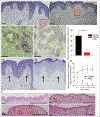Coexistence of Eph receptor B1 and ephrin B2 in port-wine stain endothelial progenitor cells contributes to clinicopathological vasculature dilatation
- PMID: 28599054
- PMCID: PMC9375175
- DOI: 10.1111/bjd.15716
Coexistence of Eph receptor B1 and ephrin B2 in port-wine stain endothelial progenitor cells contributes to clinicopathological vasculature dilatation
Abstract
Background: Port-wine stain (PWS) is a vascular malformation characterized by progressive dilatation of postcapillary venules, but the molecular pathogenesis remains obscure.
Objectives: To illustrate that PWS endothelial cells (ECs) present a unique molecular phenotype that leads to pathoanatomical PWS vasculatures.
Methods: Immunohistochemistry and transmission electron microscopy were used to characterize the ultrastructure and molecular phenotypes of PWS blood vessels. Primary culture of human dermal microvascular endothelial cells and in vitro tube formation assay were used for confirmative functional studies.
Results: Multiple clinicopathological features of PWS blood vessels during the development and progression of the disease were shown. There were no normal arterioles and venules observed phenotypically and morphologically in PWS skin; arterioles and venules both showed differentiation impairments, resulting in a reduction of arteriole-like vasculatures and defects in capillary loop formation in PWS lesions. PWS ECs showed stemness properties with expression of endothelial progenitor cell markers CD133 and CD166 in non-nodular lesions. They also expressed dual venous/arterial identities, Eph receptor B1 (EphB1) and ephrin B2 (EfnB2). Co-expression of EphB1 and EfnB2 in normal human dermal microvascular ECs led to the formation of PWS-like vasculatures in vitro, for example larger-diameter and thick-walled capillaries.
Conclusions: PWS ECs are differentiation-impaired, late-stage endothelial progenitor cells with a specific phenotype of CD133+ /CD166+ /EphB1+ /EfnB2+ , which form immature venule-like pathoanatomical vasculatures. The disruption of normal EC-EC interactions by coexistence of EphB1 and EfnB2 contributes to progressive dilatation of PWS vasculatures.
© 2017 British Association of Dermatologists.
Conflict of interest statement
Conflicts of interest
None declared.
Figures




Comment in
-
B1 and B2: a role for ephrin signalling in port-wine stain.Br J Dermatol. 2017 Dec;177(6):1478-1479. doi: 10.1111/bjd.16035. Br J Dermatol. 2017. PMID: 29313918 No abstract available.
Similar articles
-
The Pathogenesis of Port Wine Stain and Sturge Weber Syndrome: Complex Interactions between Genetic Alterations and Aberrant MAPK and PI3K Activation.Int J Mol Sci. 2019 May 7;20(9):2243. doi: 10.3390/ijms20092243. Int J Mol Sci. 2019. PMID: 31067686 Free PMC article. Review.
-
Membrane trafficking and exocytosis are upregulated in port wine stain blood vessels.Histol Histopathol. 2019 May;34(5):479-490. doi: 10.14670/HH-18-051. Epub 2018 Oct 10. Histol Histopathol. 2019. PMID: 30302745 Free PMC article.
-
Characterization of Laser-Resistant Port Wine Stain Blood Vessels Using In Vivo Reflectance Confocal Microscopy.Lasers Surg Med. 2019 Dec;51(10):841-849. doi: 10.1002/lsm.23134. Epub 2019 Jul 16. Lasers Surg Med. 2019. PMID: 31310339
-
Sustained activation of c-Jun N-terminal and extracellular signal-regulated kinases in port-wine stain blood vessels.J Am Acad Dermatol. 2014 Nov;71(5):964-8. doi: 10.1016/j.jaad.2014.07.025. Epub 2014 Aug 16. J Am Acad Dermatol. 2014. PMID: 25135651 Free PMC article.
-
Pathogenesis of Port-Wine Stains: Directions for Future Therapies.Int J Mol Sci. 2022 Oct 12;23(20):12139. doi: 10.3390/ijms232012139. Int J Mol Sci. 2022. PMID: 36292993 Free PMC article. Review.
Cited by
-
Efficacy of photodynamic therapy in the treatment of port wine stains: A systematic review and meta-analysis.Front Med (Lausanne). 2023 Feb 21;10:1111234. doi: 10.3389/fmed.2023.1111234. eCollection 2023. Front Med (Lausanne). 2023. PMID: 36895715 Free PMC article.
-
The Pathogenesis of Port Wine Stain and Sturge Weber Syndrome: Complex Interactions between Genetic Alterations and Aberrant MAPK and PI3K Activation.Int J Mol Sci. 2019 May 7;20(9):2243. doi: 10.3390/ijms20092243. Int J Mol Sci. 2019. PMID: 31067686 Free PMC article. Review.
-
Port wine stain treatment outcomes have not improved over the past three decades.J Eur Acad Dermatol Venereol. 2019 Jul;33(7):1369-1377. doi: 10.1111/jdv.15599. Epub 2019 Apr 23. J Eur Acad Dermatol Venereol. 2019. PMID: 30908756 Free PMC article.
-
Functionalized erythrocyte-derived optical nanoparticles to target ephrin-B2 ligands.J Biomed Opt. 2019 Aug;24(8):1-9. doi: 10.1117/1.JBO.24.8.085002. J Biomed Opt. 2019. PMID: 31429216 Free PMC article.
-
Membrane trafficking and exocytosis are upregulated in port wine stain blood vessels.Histol Histopathol. 2019 May;34(5):479-490. doi: 10.14670/HH-18-051. Epub 2018 Oct 10. Histol Histopathol. 2019. PMID: 30302745 Free PMC article.
References
-
- Jacobs AH, Walton RG. The incidence of birthmarks in the neonate. Pediatrics 1976; 58:218–22. - PubMed
-
- Pratt AG. Birthmarks in infants. Arch Dermatol Syphilol 1953; 67:302–5. - PubMed
-
- Geronemus RG, Ashinoff R. The medical necessity of evaluation and treatment of port-wine stains. J Dermatol Surg Oncol 1991; 17:76–9. - PubMed
-
- Lever WF, Schaumburg-Lever G. Histopathology of the Skin, 7th edn. Philadelphia, PA: JB Lippincott, 1990.
-
- Kalick SM. Toward an interdisciplinary psychology of appearances. Psychiatry 1978; 41:243–53. - PubMed
MeSH terms
Substances
Grants and funding
LinkOut - more resources
Full Text Sources
Other Literature Sources
Research Materials
Miscellaneous

